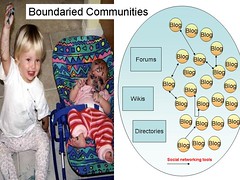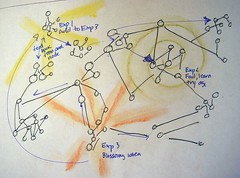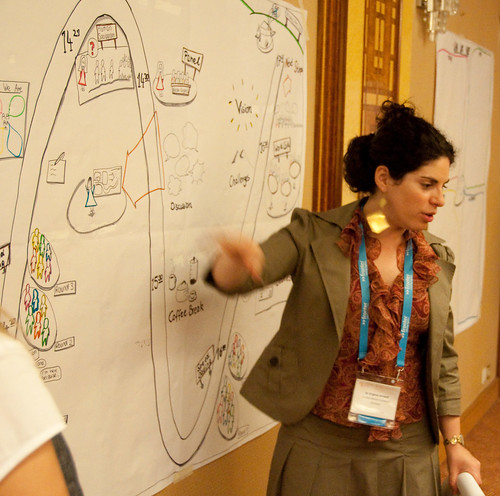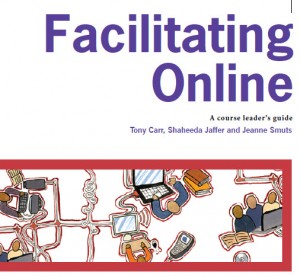It has become clear. I’m long-winded on the topic of new skills for knowledge workers and learning professionals, even if I don’t quite understand what a learning professional is. Here is part 3. You can check back to Part 1 and Part 2 if you feel as lost as I often do! 😉

When Tony Karrer asks for 5 and 60 minute learnings on what new skills do learning professional need, clearly I’m falling well past the 60 minute mark. But here is the last batch. As I noted in Part 2, these are biggies and probably could have fallen under the “meta skills” mentioned in Part 1. These three directly address the follow up question Tony left on Part 1 seeking more on what learning professionals need to know how to do to leverage the learning opportunities found in communities and networks.
 Community Leadership and Facilitation
Community Leadership and Facilitation
This is my old stomping ground both online and offline. A subset is online community management but I’ll confess to placing more emphasis both on facilitating vs managing and servant leadership vs top-down leadership. For this post, community is defined as a group of people with bounded membership who have some shared, congruent interest and interact with each other over time. These are seated in well known group facilitation theory and practices with the additional needs of an online environment. In essence, you are working in an environment where our “sixth sense” has moved from the physical observations of body language, to a more subtle and diverse practice of picking up weak signals in many media to ascertain what is happening with people online. So your superpower is signal detection!
For the 5 minute conversation questions I’d ask 1) how do your practices facilitating and leading show up in diverse modalities? (in other words, in text, on a conference call, etc.) 2) How do you help others take on facilitation and leadership roles? (emphasis on building collective leadership capacity, distributed leadership, etc.)
Here are some resources
- The 8 Competencies of Online Interaction (Audio, slides) and tons on my blog.
- Online Facilitation Wiki
Network Weaving
 Social networks, particularly those made possible through online tools, are changing how we learn and work. For this post, the definition of a network is a constellation of individuals associated via fuzzy, unbounded membership and overlapping (not fully congruent) interests. It can include one-time or repeat interaction.
Social networks, particularly those made possible through online tools, are changing how we learn and work. For this post, the definition of a network is a constellation of individuals associated via fuzzy, unbounded membership and overlapping (not fully congruent) interests. It can include one-time or repeat interaction.
What skills are critical here? And how are they different from community skills?
My sense is they include many community skills plus some additional aspects. I used the title network weaving (from June Holley) but I actually think it is broader than the weaving. It is also about visualizing, supporting etc.
Some of the sub-skills include creating connections that are object or content centric, vs the more traditional relationship-centric mode in communities, more pattern seeking instead of linear sequencing of learning actions or activities. It is augmented with tools such as social network analysis and other tools that help us “see” networks visually, as it is hard to hold a large number of nodes or members in our imaginations.
Network weaving asks us to contribute without expectation of one to one reciprocity, without a clear line of sight (or even the possibility) of seeing the results of one’s work. Often hard to evaluate with clear causality. So this really is dancing with ambiguity. We might also say network weaving may need to be a bit more ego-less. What do you think?
Here are some resources:
- A paper describing the practice of Network Weaving (PDF)
- Network Weaving – great collaborative blog of Valdis Krebs, June Holley and Jack Ricchiutto and friends.
- Network Weaver checklist from June Holley
By the way, if you are interested in the topic of networks of communities, you might enjoy this upcoming SCoPE seminar, Exploring Networks of Communities: July 6-24, 2009 which starts TODAY !
 Reflective Practice
Reflective Practice
Finally, if we don’t take the time to stop and reflect on what we are doing, we’ll miss the most important learning opportunities. A reflective practice is essential for me. In reflecting on what we do, did, intend to do, in observing what happens around us, we can learn all the time, anywhere, everywhere. Reflective practice has long been familiar to learning theorists, but there are implications new to the current “web 2” context which give us ways to have both personal and collective shared practice without being in the same place or moment in time. Here are some examples:
- Reflective writing, through unstructured writing, blogging, learning journals , (e)portfolios and structured writing exercises. I’ll note that my blog has been a very important reflective learning tool for me, both in the writing of the posts and in the responses through comments and off-blog conversation generated by the posts. If you don’t blog, consider it. Seriously. Just look at Kenny Moore’s blog!
- Reflective conversations, both unstructured and structured (such as After Action Review, Most Significant Change, Peer Assists, storytelling and others). This ties closely to the other skills of community and network. Few of us can learn alone and my peers have been incredible catalysts for both my reflective practice and my overall learning.
Photo Credit
- Please, click into this photo uploaded on June 22, 2006 by vaXzine – it is fabulous, it has lovely annotations and is a great example of visual thinking!

 I was going to say “online community management” in the title, because I know that is a hot search term, but I just could not do it. What Simon Hearn of the
I was going to say “online community management” in the title, because I know that is a hot search term, but I just could not do it. What Simon Hearn of the 
 Beyond doing
Beyond doing